Cockroach
| Cockroaches Fossil range: Carboniferous - Recent |
||||||||||||||
|---|---|---|---|---|---|---|---|---|---|---|---|---|---|---|
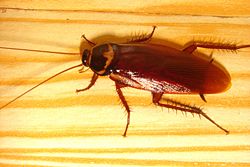 Periplaneta americana
|
||||||||||||||
| Scientific classification | ||||||||||||||
|
||||||||||||||
| Families | ||||||||||||||
|
Blaberidae |
Cockroaches (or simply "roaches") are insects of the order Blattaria. This name derives from the Latin word for "cockroach", blatta.
There are about 4,000 species of cockroach of which 30 species are associated with human habitations and about four species are well known as pests.[1][2]
Among the best-known pest species are the American cockroach, Periplaneta americana, which is about 30 millimetres (1.2 in) long, the German cockroach, Blattella germanica, about 15 millimetres (½ in) long, the Asian cockroach, Blattella asahinai, also about 15 millimetres (½ in) in length, and the Oriental cockroach, Blatta orientalis, about 25 millimetres (1 in). Tropical cockroaches are often much bigger, and extinct cockroach relatives such as the Carboniferous Archimylacris and the Permian Apthoroblattina were several times as large as these.
Contents |
Selected species
- Blaptica dubia, South American Dubia cockroach
- Blatta orientalis, Oriental cockroach
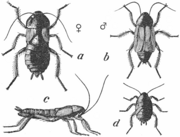 Oriental cockroach (Blatta orientalis). a, female; b, male; c, side view of female; d, young.
Oriental cockroach (Blatta orientalis). a, female; b, male; c, side view of female; d, young. - Blattella asahinai, Asian cockroach
- Blattella germanica, German cockroach
- Blaberus craniifer, true death's head cockroach
- Blaberus discoidalis, discoid cockroach or false death's head
- Eurycotis floridana, Florida woods cockroach
- Gromphadorhina portentosa, Madagascar hissing cockroach
- Parcoblatta pennsylvanica, Pennsylvania woods cockroach
- Periplaneta americana, American cockroach
- Periplaneta australasiae, Australian cockroach
- Periplaneta brunnea, brown cockroach
- Periplaneta fuliginosa, smokybrown cockroach
- Pycnoscelus surinamensis, Surinam cockroach
- Supella longipalpa, brown-banded cockroach
Evolutionary history and relationships
Mantodea, Isoptera, and Blattaria are usually combined by entomologists into a higher group called Dictyoptera. Current evidence strongly suggests that termites have evolved directly from true cockroaches, and many authors now consider termites to be a family of cockroaches,[3][4] as Blattaria excluding Isoptera is not a monophyletic group.[1]
Historically, the name Blattaria has been used largely interchangeably with the name Blattodea, though in most recent treatments, the latter name refers to a larger grouping that includes numerous fossil groups that were related to roaches, but not true cockroaches themselves. Another name, Blattoptera has come into use for this same paraphyletic group.[5] These earliest cockroach-like fossils ("Blattopterans" or "roachids") are from the Carboniferous period between 354–295 million years ago. However, these fossils differ from modern cockroaches in having long ovipositors and are the ancestors of mantids as well as modern cockroaches. The first fossils of modern cockroaches with internal ovipositors appear in the early Cretaceous.
Behavior
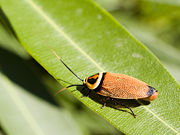
Cockroaches live in a wide range of environments around the world. Pest species of cockroaches adapt readily to a variety of environments, but prefer warm conditions found within buildings. Many tropical species prefer even warmer environments and do not fare well in the average household.
The spines on the legs were earlier considered to be sensory, but observations of their locomotion on sand and wire meshes has demonstrated that they help in locomotion on difficult terrain. The structures have been used as inspiration for robotic legs.[6][7]
Cockroaches leave chemical trails in their feces as well as emitting airborne pheromones for swarming and mating. Other cockroaches will follow these trails to discover sources of food and water, and also discover where other cockroaches are hiding. Thus, cockroaches can exhibit emergent behavior,[8] in which group or swarm behavior emerges from a simple set of individual interactions.
Research has shown that group-based decision-making is responsible for complex behavior such as resource allocation. In a study where 50 cockroaches were placed in a dish with three shelters with a capacity for 40 insects in each, the insects arranged themselves in two shelters with 25 insects in each, leaving the third shelter empty. When the capacity of the shelters was increased to more than 40 insects per shelter, all of the cockroaches arranged themselves in one shelter. Researchers found a balance between cooperation and competition exists in group decision-making behavior found in cockroaches. The models used in this research can also explain the group dynamics of other insects and animals.[8]
Cockroaches are mainly nocturnal and will run away when exposed to light. A peculiar exception is the Asian cockroach, which is attracted to light. Another study tested the hypothesis that cockroaches use just two pieces of information to decide where to go under those conditions: how dark it is and how many of their friends are there. The study conducted by José Halloy and colleagues at the Free University of Brussels and other European institutions created a set of tiny robots that to the roaches appear to be other roaches and can thus alter the roaches' perception of critical mass. The robots were also specially scented so that they would be accepted by the real roaches.[9]
Additionally, researchers at Tohoku University engaged in a Classical Conditioning experiment with cockroaches and discovered that the insects were able to associate the scent of vanilla and peppermint with a sugar treat.[10]
Physiology
Digestive tract
Cockroaches are most common in tropical and subtropical climates. Some species are in close association with human dwellings and widely found around garbage or in the kitchen. Cockroaches are generally omnivorous with the exception of the wood-eating genus Cryptocercus; these roaches are incapable of digesting cellulose themselves, but have symbiotic relationships with various protozoans and bacteria that digest the cellulose, allowing them to extract the nutrients. The similarity of these symbionts to those in termites are such that the genus Cryptocercus has been believed to be more closely related to termites than to other cockroaches,[11] and current research strongly supports this hypothesis of relationships.[12] All species studied so far carry the obligate mutualistic endosymbiont bacterium Blattabacterium cuenoti, with the exception of Nocticola australiensise, an Australian cave dwelling species without eyes, pigment or wings, and which recent genetic testing indicates could be a missing link between cockroaches and mantises.[13] [14]
Trachea and breathing
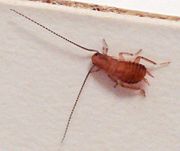
Cockroaches, like all insects, breathe through a system of tubes called tracheae. The tracheae of insects are attached to the spiracles, excluding the head. Thus cockroaches, like all insects, are not dependent on the mouth and windpipe to breathe. The valves open when the CO2 level in the insect rises to a high level; then the CO2 diffuses out of the tracheae to the outside and fresh O2 diffuses in. Unlike in vertebrates that depend on blood for transporting O2 and CO2, the tracheal system brings the air directly to cells, the tracheal tubes branching continually like a tree until their finest divisions, tracheoles, are associated with each cell, allowing gaseous oxygen to dissolve in the cytoplasm lying across the fine cuticle lining of the tracheole. CO2 diffuses out of the cell into the tracheole.
While cockroaches do not have lungs and thus do not actively breathe in the vertebrate lung manner, in some very large species the body musculature may contract rhythmically to forcibly move air out and in the spiracles; this may be considered a form of breathing. [2]
Nervous system
Like all insects, the cockroach nervous system is decentralized, with some functions distributed in the ventral ganglia. Though decentralized, the insect nervous system is fundamentally similar to that of vertebrates in terms of development, structure, and mechanisms of function. A decapitated cockroach can still walk and show responses to stimulation of its legs, as can a spinal-transected cat on a treadmill. However, a cockroach can survive complete decapitation for up to several weeks before dying of starvation or dehydration.[15]
Eggs and egg capsules
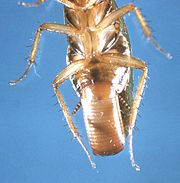
Female cockroaches are sometimes seen carrying egg cases on the end of their abdomen; the egg case of the German cockroach holds about 30–40 long, thin eggs, packed like frankfurters in the case called an ootheca. The eggs hatch from the combined pressure of the hatchlings gulping air and are initially bright white nymphs that continue inflating themselves with air and harden and darken within about four hours. Their transient white stage while hatching and later while molting has led to many claims of glimpses of an albino cockroach.
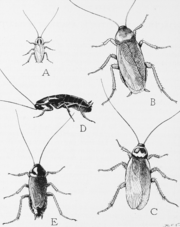
A female German cockroach carries an egg capsule containing around 40 eggs. She drops the capsule prior to hatching, though live births do rarely occur. Development from eggs to adults takes 3-4 months. Cockroaches live up to a year. The female may produce up to eight egg cases in a lifetime; in favorable conditions, it can produce 300-400 offspring. Other species of cockroach, however, can produce an extremely high number of eggs in a lifetime, but in some cases a female only needs to be impregnated once to be able to lay eggs for the rest of her life.
Sounds
Aside from the famous hissing noise, some cockroaches (including a species in Florida) will make a chirping noise.
Size
Cockroaches are rather large insects. Most species are about the size of a thumbnail, but several species are bigger. The world's largest cockroach is the Australian giant burrowing cockroach, which can reach 9 cm in length and weigh more than 30 grams. Comparable in size is the Central American giant cockroach Blaberus giganteus, which grows to a similar length but is not as heavy.
Hardiness
Cockroaches are among the hardiest insects on the planet, some species capable of remaining active for a month without food, or being able to survive on limited resources like the glue from the back of postage stamps.[16] Some can go without air for 45 minutes or slow down their heart rate.
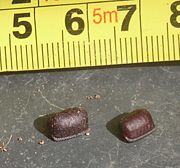
It is popularly suggested that cockroaches will "inherit the earth" if humanity destroys itself in a nuclear war. Cockroaches do indeed have a much higher radiation resistance than vertebrates, with the lethal dose perhaps 6 to 15 times that for humans. However, they are not exceptionally radiation-resistant compared to other insects, such as the fruit fly.[17]
The cockroach's ability to withstand radiation better than human beings can be explained in terms of the cell cycle. Cells are most vulnerable to the effects of radiation when they are dividing. A cockroach's cells divide only once each time it molts, which is weekly at most in a juvenile roach. Since not all cockroaches would be molting at the same time, many would be unaffected by an acute burst of radiation, but lingering radioactive fallout would still be harmful.[18]
Role as pests
Cockroaches are one of the most commonly noted household pest insects. They feed on human and pet food and damage and can leave an offensive odor.[19] They can also passively transport microbes on their body surfaces including those that are potentially dangerous to humans, particularly in environments such as hospitals.[20][21] Cockroaches infestations have been shown to be linked with allergic reactions in humans.[22][23] One of the proteins that triggers allergic reactions has been identified as tropomyosin.[24] These allergens have also been found to be linked with asthma.[25]
General preventative measures against household pests include keeping all food stored away in sealed containers, using garbage cans with a tight lid, frequent cleaning in the kitchen, and regular vacuuming. Any water leaks, such as dripping taps, should also be repaired. It is also helpful to seal off any entry points, such as holes around baseboards, in between kitchen cabinets, pipes, doors, and windows with some steel wool or copper mesh and some cement, putty or silicone caulk.
American cockroaches have been known to live up to three months without food and a month without water. Frequently living outdoors, although preferring warm climates and considered "cold intolerant," they are resilient enough to survive occasional freezing temperatures. This makes them difficult to eradicate once they have infested an area.

There are numerous parasites and predators of cockroaches, but few of them have proven to be highly effective for biological control. Wasps in the family Evaniidae are perhaps the most effective insect predators, as they attack the egg cases, and wasps in the family Ampulicidae are predators on adult and nymphal cockroaches (e.g., Ampulex compressa). The house centipede is probably the most effective control agent of cockroaches, though many homeowners find the centipedes themselves objectionable.
Bait stations, gels containing hydramethylnon or fipronil, as well as boric acid powder, are toxic to cockroaches.[26] Baits with egg killers are also quite effective at reducing the cockroach population. Additionally, pest control products containing deltamethrin or pyrethrin are very effective.[26]
Trapping can reveal the hiding places and the seriousness of the infestation. Trapping alone will not eliminate cockroaches, but should be used with preventive measures for better results. Many inexpensive cockroach traps are available. They are easy to use, disposable and contain no toxic insecticide. Most are box shaped and coated with a very sticky adhesive inside. Some traps may also feature slow release food attractant. Cockroaches enter the trap when detecting the food odor and stick to the adhesive. Place traps where cockroaches are likely to travel. Change the trap's position if no cockroaches are caught after two or three nights.The number of traps required will depend on the kind of cockroach present and location of the infestation.
To control cockroaches with insecticides, find their daytime hiding place and thoroughly treat those areas. Regardless of the insecticide chosen, chemicals placed in or near regular hiding places provide much better control than those placed where cockroaches move only occasionally. Since some cockroach species invade homes and buildings from outside, they may reinfest dwellings once the insecticide dissipates. To solve this problem, outdoor populations must also be controlled. The type of chemical selected and the application method used depend on the location and nature of the infestation. No one chemical handles all cockroach problems, but a combination of various types is effective.
In Singapore and Malaysia, taxi drivers use Pandan leaves as a cockroach repellent in their vehicles.[27] In Russia, some people, after opening all cupboards, leave a saucepan half-full of sulfur burning on a gas ring, then quickly come back in to switch it off (with gas mask) and leave the residence for a few days. This is said to be protective for ten years.
Recently, a method called the Vegas roach trap has gained popularity as a successful way to control a cockroach infestation.
Some of the earliest writings about cockroaches encouraged their use as medicine. Pedanius Dioscorides (1st century), Kamal al-Din al-Damiri and Abu Hanifa ad-Dainuri (9th century) all offered medicines that either suggest grinding them up with oil or boiling them. The list of ailments to be treated included earaches, open wounds and "gynecological disorders."
Pest control is cited as one of the reasons for reduced populations of cockroaches in ex-USSR countries.[3]
Cultural references
Because of their long, persistent association with humans, cockroaches are frequently referred to in art, literature, folk tales and theater and film. In Western culture, cockroaches are often depicted as vile and dirty pests. Their size, long antennae, shiny appearance and spiny legs make them disgusting to many humans, sometimes even to the point of phobic responses.[28][29] This is borne out in many depictions of cockroaches, from political versions of the song La Cucaracha where political opponents are compared to cockroaches, through the 1982 movie Creepshow and TV shows such as the X-files, to the Hutu extremists' reference to the Tutsi minority as cockroaches during the Rwandan Genocide in 1994 and the controversial cartoons published in the "Iran weekly magazine" in 1996 which implied a comparison between Iranian Azeris and cockroaches. In the movie Men in Black a giant alien cockroach is shown as a predator who eats a farmer and then uses his skin to disguise itself as a human being.
Not all depictions of cockroaches are purely negative, however. In the film Joe's Apartment, the cockroaches help the titular hero, and the narrator of the book archy and mehitabel is a sympathetic cockroach. In the book Revolt of the Cockroach People, an autobiographical novel by Oscar Zeta Acosta, cockroaches are used as a metaphor for oppressed and downtrodden minorities in US society in the 1960s and 70s. The image of cockroaches as resilient also leads people to compare themselves to cockroaches. Madonna has famously quoted, "I am a survivor. I am like a cockroach, you just can't get rid of me."[30] "Cockroach", or some variant of it is also used as a nickname, for example Boxing coach Freddie Roach, who was nicknamed La Cucaracha (The Cockroach) when he was still competing as a fighter.
References
Notes
- ↑ Valles SM, Koehler PG, Brenner RJ. (1999) Comparative insecticide susceptibility and detoxification enzyme activities among pestiferous blattodea. Comp Biochem Physiol C Pharmacol Toxicol Endocrinol. 124(3):227-32 PMID: 10661713
- ↑ Schal, C & R. L. Hamilton (1990) Integrated suppression of synanthropic cockroaches. Annu. Rev. Entomol 35:521-51 PDF
- ↑ "Termites are 'social cockroaches'" (in English), BBC News (13 April 2007).
- ↑ Eggleton, P. &al. (2007), Biological Letters, June 7, cited in Science News vol. 171, p. 318
- ↑ Grimaldi, D (1997): A fossil mantis (Insecta: Mantoidea) in Cretaceous amber of New Jersey, with coments on early history of Dictyoptera. American Museum Novitates 3204: 1-11
- ↑ Roy E. Ritzmann, Roger D. Quinn, Martin S. Fischer (2004) Convergent evolution and locomotion through complex terrain by insects, vertebrates and robots. Arthropod Structure & Development 33:361–379 http://www.case.edu/artsci/biol/ritzmann/Ritzmann%204.pdf PDF]
- ↑ Spagna, J C, D I Goldman, P-C Lin, D E Koditschek, Robert J Full (2007) Distributed mechanical feedback in arthropods and robots simplifies control of rapid running on challenging terrain. Bioinspir Biomim. 2(1):9-18
- ↑ 8.0 8.1 Jennifer Viegas. "Cockroaches Make Group Decisions". Discovery Channel. Retrieved on 10 June 2006.
- ↑ Lemonick, Michael D. (2007-11-15). "Robotic Roaches Do the Trick". Time Magazine.
- ↑ Wynne Parry. "Pavlovian Cockroaches Learn Like Dogs (and Humans)". Discover Magazine. Retrieved on 5 September 2007.
- ↑ Eggleton, P. (2001). Termites and trees: a review of recent advances in termite phylogenetics. Insectes Sociaux 48: 187-193.
- ↑ Evidence for Cocladogenesis Between Diverse Dictyopteran Lineages and Their Intracellular Endosymbionts
- ↑ Cave may hold missing link
- ↑ Cockroaches that lack Blattabacterium endosymbionts: the phylogenetically divergent genus Nocticola
- ↑ Choi, Charles (2007-03-15). "Fact or Fiction?: A Cockroach Can Live without Its Head". Scientific American. http://www.sciam.com/article.cfm?articleID=5244F57C-E7F2-99DF-3E40BA295C3DCC0A&sc=I100322. Retrieved on 2007-06-29.
- ↑ Mullen, Gary; Lance Durden, Cameron Connor, Daniel Perera, Lynsey Little, Michael Groves and Rebecca Erskine. Medical and Veterinary Entomology (2002 ed.). pp. p.32. ISBN 0-12510-451-0.
- ↑ "Cockroaches & Radiation". Retrieved on 10 June 2006.
- ↑ Joseph G. Kunkel. "Are cockroaches resistant to radiation?". Retrieved on 10 June 2006.
- ↑ Brenner, R.J., Koehler, P. and Patterson, R.S. (1987)Health Implications of Cockroach Infestations, Infestations in Med 4(8): 349-355
- ↑ C. Rivault, A. Cloarec and A. Le Guyader (1993) Bacterial Load of Cockroaches in Relation to Urban Environment. 110(2):317-325
- ↑ Elgderi RM, Ghenghesh KS, Berbash N. (2006) Carriage by the German cockroach (Blattella germanica) of multiple-antibiotic-resistant bacteria that are potentially pathogenic to humans, in hospitals and households in Tripoli, Libya. Ann Trop Med Parasitol. 100(1):55-62.
- ↑ Bernton, H.S. and Brown, H. (1964) Insect Allergy Preliminary Studies of the Cockroach. J. Allergy 35: 506-513, 1964.
- ↑ Kutrup, B (2003) Cockroach Infestation in Some Hospitals in Trabzon, Turkey. Turk. J. Zool. 27:73-77 PDF
- ↑ Santos AB, Chapman MD, Aalberse RC, Vailes LD, Ferriani VP, Oliver C, Rizzo MC, Naspitz CK, Arruda LK. (1999) Cockroach allergens and asthma in Brazil: identification of tropomyosin as a major allergen with potential cross-reactivity with mite and shrimp allergens. J Allergy Clin Immunol. 104(2 Pt 1):329-37.
- ↑ Kang B, Vellody D, Homburger H, Yunginger JW. (1979) Cockroach cause of allergic asthma. Its specificity and immunologic profile. J. Allergy Clin. Immunol. 63(2):80-6.
- ↑ 26.0 26.1 "Cockroaches". Alamance County Department of Environmental Health. Retrieved on 11 May 2008.
- ↑ Li J. and Ho S.H. Pandan leaves (Pandanus amaryllifolius Roxb.) As A Natural Cockroach Repellent. Proceedings of the 9th National Undergraduate Research Opportunites Programme (2003-09-13).
- ↑ David Berle (2007) Graded Exposure Therapy for Long-Standing Disgust-Related Cockroach Avoidance in an Older Male. Clinical Case Studies 6(4):339-347 DOI: 10.1177/1534650106288965
- ↑ C.M. Botella, M.C. Juan, R.M. Banos, M. Alcaniz, V. Guillen, B. Rey. (2005) Mixing Realities? An Application of Augmented Reality for the Treatment of Cockroach Phobia. CyberPsychology & Behavior. 8(2): 162-171. doi:10.1089/cpb.2005.8.162.
- ↑ "I am a survivor. I am like a cockroach, you just can't get rid of me." - Madonna
Bibliography
- Cockroaches: Ecology, Behavior, and Natural History, by William J. Bell, Louis M. Roth, and Christine A. Nalepa, ISBN 0-8018-8616-3, 2007
- Firefly Encyclopedia of Insects and Spiders, edited by Christopher O'Toole, ISBN 1-55297-612-2, 2002
- Insects: Their Biology and Cultural History, Bernhard Klausnitzer, ISBN 0-87663-666-0, 1987
External links
- Blattodea Species File Online world catalogue of cockroaches.
- Cockroaches – least toxic control - alternatives to pesticides fact sheet from PAN UK.
- Online book about cockroaches
- Allpet Roaches Photos and information about pet relevant species.
- Order Blattodea (Cockroaches), Exploring California Insects photos of a few California species
- [4] Cockroach Control
- Cockroach health threats
- UC Davis on cockroaches
- The cockroach FAQ
- Cockroach Pest Control Information - National Pesticide Information Center
- Harvard University fact sheet on American cockroaches
- Cosmic cockroaches faster developers, Russian scientists say
- Cockroaches: Household Pests
- American cockroach on the University of Florida/Institute of Food and Agricultural Sciences Featured Creatures Web site
- Asian cockroach on the UF/IFAS Featured Creatures Web site
- German cockroach on the UF/IFAS Featured Creatures Web site
- oriental cockroach on the UF/IFAS Featured Creatures Web site
- a cockroach egg parasitoid on the UF/IFAS Featured Creatures Web site
- Cockroaches chapter in United States Environmental Protection Agency and UF/IFAS National Public Health Pesticide Applicator Training Manual
- A phylogenetic analysis of Dictyoptera (Insecta) based on morphological characters